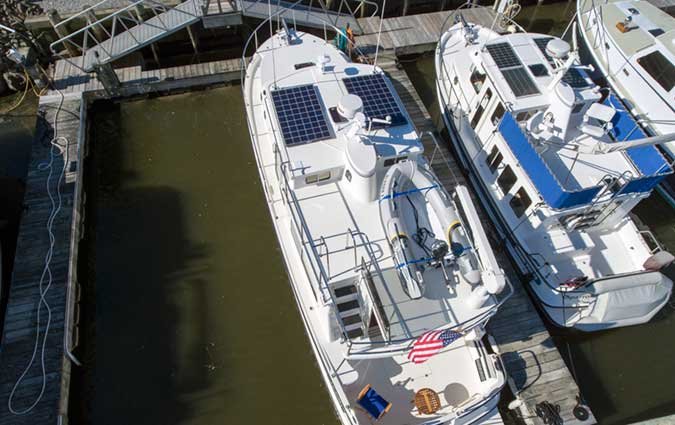
Marine Solar Panels
For a long time, overnighting on a mooring or anchoring anywhere away from shore power meant either doing without most of the comforts of electricity or relying heavily on a noisy diesel generator. Only by firing up the mini power plant to recharge the batteries could you have your electronics, lighting, and much more at your service.
Now, skippers of small boats often use solar panels as trickle chargers to maintain battery banks and electronics devices. This is particularly helpful, for example, if you are on a mooring, have power outages at the dock, or just want to keep your batteries up while fishing, hanging off the beach, or quietly drifting without using that outboard. Others use large banks of panels to supply most or all of the current for living aboard, even including running refrigeration powered by batteries. Regardless of how you want to use solar panels, solar-power efficiency has made significant strides in recent years, so it helps to understand some basics.
Types Of Panels
There are three distinct types, each available with different kinds of silicon cells.
Monocrystalline cells have the highest efficiency rates because they're cut from a single crystal of the highest-grade silicon, have the longest life expectancy (more than 25 years), and require less space because of their efficiency.
Polycrystalline (or multicrystalline) cells, made from off-cuts and recycled silicon, are less durable and slightly less efficient; they tend to require more space. Both monocrystalline and polycrystalline cells are found in the familiar hard panels you see mounted on decks and pilothouse tops as well as in lightweight semiflexible and walk-on marine panels. Semiflexible panels with zippers or hook-and-loop fasteners added to them can be mounted in such canvas areas as biminis and dodgers, while walk-on panels can be secured directly to a deck or hard cabin top and absorb foot traffic. A good way to distinguish monocrystalline and polycrystalline solar panels is that polycrystalline solar cells look perfectly rectangular, with no rounded corners.
Amorphous solar panels are flexible "roll-up" panels named after the type of silicon used to manufacture them. These are the least efficient but most versatile.
Solar-panel efficiency is a measurement of how much solar irradiation the panel is able to convert to electricity. Each type has a different efficiency. While products constantly evolve, a general rule of thumb, according to Warren, is that efficiencies range from as low as 10 percent, for thin-film panels, to about 18 percent, for most polycrystalline panels, and to as high as 23 percent, for some monocrystalline panels that use more advanced technologies. This means that, for the size, the best, most-efficient panels can produce substantially more power than the least-efficient panels.
The Cost Of Clean Power
Of the three distinct formats of marine solar panels, the aluminum-framed glass panels are the least expensive, as they use a standardized construction process. The semiflexible and walk-on panels are highly specialized items made in small quantities, so they're more expensive. Genuine high-grade SunPower back-contact monocrystalline cells are currently the most efficient ones available and give a higher daily yield, but at a premium price. Amorphous panels are relatively inefficient panels and command a high dollar-per-watt price for their ability to be placed on rounded surfaces.
"There's a world of difference between true high-performance marine solar panels and those used on residential and commercial properties. Prices reflect that.